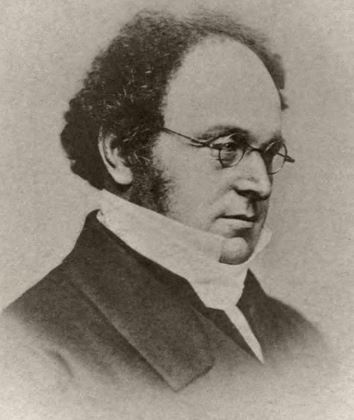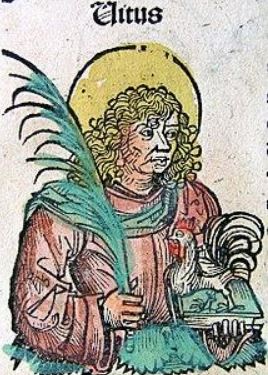 As I discussed last week, pi (π) is a transcendental number, 3.1415926535…, whose decimal expansion never ends. It is therefore impossible to do what ancient mathematicians were keen to do, namely to draw a square that has exactly the same area as a given circle. This process is known as squaring the circle, which has become a byword for doing something impossible. The earliest recorded instance is from a sermon of John Donne, preached at St Paul’s on Christmas Day 1624: “God is a circle himselfe, and he will make thee one; Goe not thou about to square eyther circle [i.e. neither God nor yourself], to bring that which is equall in it selfe, to Angles, and Corners, into dark and sad suspicions of God, or of thy selfe, that God can give, or that thou canst receive no more mercy, than thou hast had already.”
As I discussed last week, pi (π) is a transcendental number, 3.1415926535…, whose decimal expansion never ends. It is therefore impossible to do what ancient mathematicians were keen to do, namely to draw a square that has exactly the same area as a given circle. This process is known as squaring the circle, which has become a byword for doing something impossible. The earliest recorded instance is from a sermon of John Donne, preached at St Paul’s on Christmas Day 1624: “God is a circle himselfe, and he will make thee one; Goe not thou about to square eyther circle [i.e. neither God nor yourself], to bring that which is equall in it selfe, to Angles, and Corners, into dark and sad suspicions of God, or of thy selfe, that God can give, or that thou canst receive no more mercy, than thou hast had already.”
Squaring the circle has also been called quadrature, although that term applies more generally in mathematics to the process of constructing a square that is equal in area to that of any other geometrical figure. In Latin quadratura meant division of land into squares so that it could be accurately surveyed.
Of course, the impossibility of the task hasn’t prevented a large number of cranks from attempting it; they not infrequently claim that they have succeeded and that π has some value such as √10 (3.16228), or 3⅛ (3.125), or 19/6 (3.16666…), or 3×7.1/50 (3.142).

The British mathematician Augustus de Morgan discussed the circle squarers at length in his posthumously published book A Budget of Paradoxes (1872), in which he identified various types of cranks, who were wont to attempt proven impossible tasks: “squarers of the circle, trisectors of the angle, duplicators of the cube, constructors of perpetual motion, subverters of gravitation, stagnators of the earth, builders of the universe.”
De Morgan called them “paradoxers”, and in a paper in the Journal of the Institute of Actuaries in January 1867, he likened their obsession to St Vitus’ dance. “I pronounce and ordain,” he wrote “by right accruing from the trouble I have taken in this subject, that he, St Vitus, who leads his votaries a never-ending and unmeaning dance, shall henceforth be held and taken to be the patron saint of the circle-squarer. His day is the 15th of June, which is also that of St Modestus, with whom the said circle-squarer often has nothing to do. … The arch-priest of St Vitus will have it that the square inscribed in a semicircle is half of the semicircle, or the circumference 3⅕ diameters.”
Vitus was a Sicilian who died a martyr in 303 AD, during the persecution of Christians by the Roman co-Emperors Diocletian (in the East) and Maximian (in the West). His nurse Crescentia and her husband Modestus, his tutor, were similarly martyred, and in places the three have been celebrated jointly. At shrines that were later set up in his honour, devotees would dance so joyously that Vitus became the patron saint of dancers, actors, and people with epilepsy, whose convulsions were regarded as a form of dancing. St Vitus’ dance was then applied to the specific form of disorder otherwise known as chorea (Greek χορεία, dance) or Sydenham’s chorea, to distinguish it from other forms, since it was first described by Thomas Sydenham in Schedula Monitoria de Novis Febris Ingressu (1686): “Cuius rei experimentum a me factum in medium profero, nempe in quadam Convulsionis specie quæ Chorea Sancti Viti vulgo appellatur” (“I experimentally demonstrate [the effects of venesection and purgation] in that type of seizure commonly called St Vitus dance”).

The English term “St Vitus dance” is first recorded in Robert Burton’s Anatomy of Melancholy: “Chorus sancti Viti, or Saint Vitus dance, the lascivious dance, Paracelsus calls it, because they that are taken with it, can doe nothing but dance till they be dead, or cured. It is so called, for that the parties so troubled, were wont to goe to Saint Vitus for helpe, & after they had danced there a while, they were certainly freed. ’Tis strange to heare how long they will dance, and in what manner, over stooles, formes, tables, even great bellyed women sometimes (and yet never hurt their childe) will dance so long, that they can stirre neither hand nor foot, but seeme to be quite dead.”
We still suffer from fervently dancing circle squarers today, from those who think that ineffective remedies are effective to those who think that effective remedies are excessively harmful. Extremists and cranks are, of course, to be found at either end of the spectrum.
Jeffrey Aronson is a clinical pharmacologist, working in the Centre for Evidence Based Medicine in Oxford’s Nuffield Department of Primary Care Health Sciences. He is also president emeritus of the British Pharmacological Society.
Competing interests: None declared.
